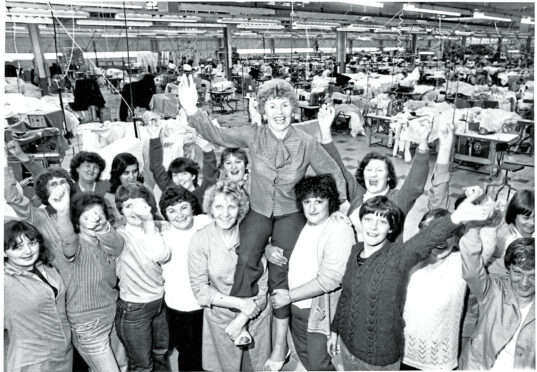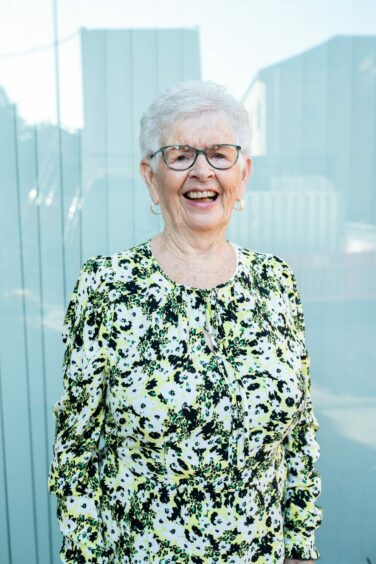
They are the women who took on The Man – and won.
Now a leading historian is calling for the inspirational women who scored major victories against big business to be cemented in the streets and the annals of Scottish history.
Dr Andrew Clark, research associate with the Newcastle University Oral History Collective, says the achievements of the women involved in major industrial disputes in factories across Scotland 40 years ago should be commemorated to ensure their achievements are remembered alongside better-known male trade unionists.
Clark grew up in Greenock, Inverclyde, and was inspired to write a book after studying the significance of the Lee Jeans sit-in of 1981, when a group of women occupied a garment factory in the town in a fight to secure their jobs.
The seven-month wildcat action not only saved the jobs of 140 women in a battle against US-based employers, the Vanity Fair Corporation, it inspired women in factories in Bathgate and Cumbernauld to do the same.
Clark said: “National narratives are built up around any historical period, and for the 1980s in Scotland it’s very much the story of working-class men fighting against the Thatcher government and ultimately being defeated.
“The mines closed, the yards closed, Upper Clyde Shipbuilders eventually went too.
“This story runs completely counter to that because it’s women workers. Not only is their gender significant, but so is the fact that they won.”
Following the success of the Lee Jeans occupation in 1981, the following year a largely female workforce at Bathgate’s Plessey electronics plant fought plans to make 330 redundant.
In the same year, the workers of bra manufacturers Lovable in Cumbernauld also organised an occupation in a fight for 300 jobs.
This widespread spirit of determination, fired by injustice over corporations’ plans to add to what were already punishing mass unemployment figures in 1980s Scotland, sprung first from the action of the women in Greenock, led by doughty shop steward Helen Monaghan.
She led the shopfloor protests at bosses’ attempts to shift production to Northern Ireland, having exhausted local government business incentives in Inverclyde.
They won support from high-ranking politicians and trade unionists such as Tony Benn and Mick McGahey, and their spirit and defiance caught the attention of media around the world.
“Female unemployment in the area was 50% higher than it was elsewhere in Scotland at the time,” said Clark. “The first thing they achieved was keeping the factory open, and that was hugely significant. When it was opened in the 1970s, it was seen as being the future, it was a modern industry.
“But, within 10 years, it was no more dependable than the other industries that had been closing. The writing was on the wall that Greenock was becoming a de-industrialised area yet it was a group of women in Larkfield Industrial Estate in Greenock that said this wasn’t acceptable, that they didn’t believe what the corporation was telling them, and that they’d sit it out until they listened to their demands.
“These women demonstrated that by refusing to accept the flawed rationale of multi-national capitalism, they could fight back, they could organise. And that inspired others.”
Yet the women of these factories had more than the threat of losing their job to contend with.
Clark said: “The trade union movement of the 20th Century was incredibly misogynistic. Women weren’t put in positions of influence, so a group of women front and centre in a dispute like the one at Lee Jeans certainly would have emboldened the women at other factories.
“The workers at Lee Jeans were actually told by their trade union to stop their action. If that happened in a workplace with a male workforce, they’d do what their officer instructed but they were told ‘This isn’t your fight. It’s not your job on the line.’”
Lee jeans workers hailed 40 years on from Greenock denim factory occupation
Jimmy Reid and the men who staged the famous work-in on the upper Clyde in 1971 have gone on to define Scotland’s spirit of working-class defiance and strength in unity but Clark believes the women of Lee Jeans, Plessey and Lovable should be equally lauded.
He said: “These occupations should be as well-known and celebrated across Scotland as Jimmy Reid, the miners’ strikes and the Ravenscraig steelworkers. It should be a part of the story of what it meant to be living in Scotland under the Thatcher government
“To tell the story of working-class Scotland without talking about them is not sufficiently covering what it meant to be working-class Scottish at that time.
“The memory of these events is precarious. We must take proactive steps with the women involved and local and national government to discuss how we secure them as part of Scotland’s working-class story.
“There should be public memorials, statues or murals in Greenock, Bathgate and Cumbernauld, so that people don’t have to go looking for the stories of these women.”
“We’re seeing an increase in workers pushing back against unfairness. This is the point where certain organisations might be pointing back and looking towards these historic examples of workers fighting back against the odds when nobody thought they’d a chance of winning.”
Fighting Deindustrialisation: Scottish Women’s Factory Occupations, 1981-1982 by Andy Clark is published by Liverpool University Press
Documentary, Sitting Tight: The Story of The Lee Jeans Sit-In can be seen on Vimeo

Enjoy the convenience of having The Sunday Post delivered as a digital ePaper straight to your smartphone, tablet or computer.
Subscribe for only £5.49 a month and enjoy all the benefits of the printed paper as a digital replica.
Subscribe © Andrew Cawley
© Andrew Cawley © Jamie Williamson
© Jamie Williamson